
One Good Turn
Sleep aids can help people with neuromuscular diseases and their caregivers get a good night's sleep
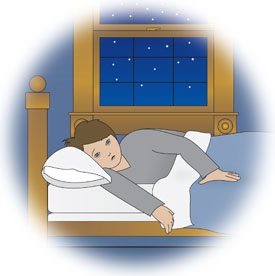 When turning over in bed becomes difficult for a person with muscle weakness, usually two people suffer sleep deprivation — the “turnee” and the “turner,” or person who wakes up several times a night and helps with repositioning.
When turning over in bed becomes difficult for a person with muscle weakness, usually two people suffer sleep deprivation — the “turnee” and the “turner,” or person who wakes up several times a night and helps with repositioning.
Consequently, any sleep aid for people with mobility problems is a sleep aid for their caregivers as well. Although some sleep aids, such as alternating pressure mattresses or turning beds, can be pricey, they provide a two-for-one solution to a frustrating problem, and pay big health dividends over time.
Why get a sleep aid?
Proper bed positioning is more than a matter of comfort. Besides allowing a family member with a neuromuscular disease to sleep longer without needing to be turned, positioning improves circulation and minimizes the swelling associated with severe weakness and muscle inactivity.
Other benefits include prevention of skin breakdown (pressure sores) and reduction of nighttime muscle spasms. More comfortable, better-rested people have fewer respiratory illnesses, use fewer sleeping pills and have an enhanced quality of life.
Sleep aids also help preserve caregivers’ strength and protect their backs from injury caused by repeated lifting of another person. Sleep aids even can protect caregivers’ emotional and mental health.
Caregivers who are tired, worn out and stressed are on a dangerous road to burnout. Research shows a clear correlation between insufficient sleep and severe depression in caregivers. Chronic sleep deprivation contributes to memory problems, lowered resistance to disease, unwanted weight gain, and increased risk of stroke, heart attack and adult-onset diabetes. In addition, severely exhausted caregivers may sleep through emergencies, such as the sounding of a vent alarm.
Clearly, a good night’s sleep is an essential part of a healthy lifestyle for both people with muscle diseases and their caregivers. The question is: How do you get it?
The answer varies, of course, but help probably can be found somewhere in a range of low-to-high-tech (and low-to-high-priced) strategies — from nylon pajamas to Space Age automatic turning beds. Here are some of the available options.
Low-tech sleep aids
Pillows create a customized sleep nest. Use them to prop the back for side lying, or place between knees or ankles to decrease pressure and reduce hip contractures. “Float” sensitive heels above the mattress by placing pillows under ankles, and use U-shaped travel neck pillows to support the neck.
If large body pillows don’t work, especially for children, parents recommend small pillows similar to airline flight pillows. Also, some caregivers use Moshi, or squishy, pillows filled with micro beads that come in various shapes and sizes.
Draw sheets are simple yet effective aids. Place a flat sheet under the sleeper extending from shoulder level to buttocks, with at least 6 inches of sheet overhanging on each side. By pulling on the overhanging sheet, a caregiver can more easily slide or roll the person to a new position. Slider Sheets offers mooveez draw sheets ($135) that slide easily, without any lifting, thanks to their blend of poly/cotton and nylon.
Satin or nylon sheets and pajamas decrease friction, making turning and repositioning easier.
A heavy belt or strap tied to the bedposts or a bed frame helps those with weak muscles gain leverage to turn themselves.
Do-it-yourself mattresses made from washable synthetic sheepskin padding or commercial egg-crate foam can be placed under a fitted sheet for more comfort. Inflatable camping mattresses can serve the same purpose.
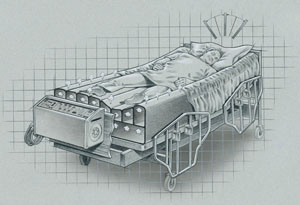 Three on, three off may be the best schedule for caregivers who get up frequently during the night. If caregivers share nighttime duties, experts have found that getting up three nights in a row, followed by three uninterrupted nights, makes caregivers feel more rested than schedules that alternate duties more frequently, such as taking turns during the same night.
Three on, three off may be the best schedule for caregivers who get up frequently during the night. If caregivers share nighttime duties, experts have found that getting up three nights in a row, followed by three uninterrupted nights, makes caregivers feel more rested than schedules that alternate duties more frequently, such as taking turns during the same night.
Medium-tech sleep aids
Hospital-style beds allow for easier positioning either by the caregiver or — with a remote control — by the person in bed. A sleeper’s weight can be shifted by raising/lowering the head and foot of the bed. Adjustable-height beds also reduce the risk of caregiver injury; raising the bed eliminates stooping and bending, and lowering it facilitates wheelchair transfers.
A mattress overlay is placed on top of an existing mattress for added comfort. Fabricated in pressure-relieving patterns from foam, rubber, polyurethane or gels, they encourage good blood flow to the skin and help prevent bedsores.
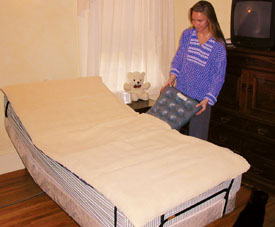 Ethan Och, 8, of Swanville, Minn., has type 2 spinal muscular atrophy, and once needed to be turned 12 to 20 times a night. His parents tried products ranging from foam egg-crate mattress overlays to a Tempur-Pedic bed, but nothing worked.
Ethan Och, 8, of Swanville, Minn., has type 2 spinal muscular atrophy, and once needed to be turned 12 to 20 times a night. His parents tried products ranging from foam egg-crate mattress overlays to a Tempur-Pedic bed, but nothing worked.
“There were nights where I had no patience left,” said his mother, Stephenie.
Now, Ethan uses a PressureGuard CFT (Constant Force Technology) pressure-relieving air mattress from Span-America Medical Systems (starting at about $2,000), and the Ochs take turns turning him four to six times a night. It’s been a major improvement.
“It was very frustrating before, but this mattress has made such a difference. Everyone gets more sleep, and everyone is happier,” Stephenie said.
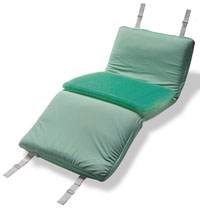 Alternating pressure mattresses work by automatically inflating and deflating mattress cells along their length. They cost anywhere from $200 to $15,000, and usually are covered by insurance. Overlays fit over an existing mattress, while replacement systems fit most standard hospital-style beds. Mattresses can be programmed with different pressure settings and time intervals.
Alternating pressure mattresses work by automatically inflating and deflating mattress cells along their length. They cost anywhere from $200 to $15,000, and usually are covered by insurance. Overlays fit over an existing mattress, while replacement systems fit most standard hospital-style beds. Mattresses can be programmed with different pressure settings and time intervals.
Lee Chamberlain, 21, has Duchenne muscular dystrophy and can’t turn over independently. Chamberlain, of Maplewood, N.J., tried virtually every low- and medium-tech product on the market before learning about SenTech Medical System’s Stage IV 3000 therapeutic mattress system ($9,990).
The key to his comfort lies in the mattress’s three pressure zones that can be customized for the head, trunk and foot sections. His height and weight are entered into the system, which then automatically sets the appropriate air pressures for each zone.
“It’s like a miracle,” said Chamberlain’s mother, Kathleen. “There are less expensive ones that are set at one pressure for the entire mattress. But if his head and torso were comfortable, then his feet were not. This way he can set the foot part for a lesser degree of air pressure, and his feet won’t be in pain and get pressure sores.”
Lee still requires assistance two to five times nightly, but he’s been pain-free since getting the alternating pressure mattress.
Another advantage, said Kathleen, is that “now that he’s getting enough sleep, it has put him in a different frame of mind because he’s more rested.”
High-tech sleep aids
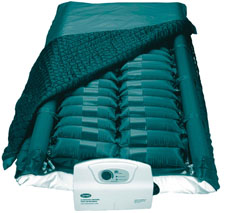 Turning mattresses use inflation and deflation to actually turn the sleeper from side to side, rather than simply alternating the underlying firmness.
Turning mattresses use inflation and deflation to actually turn the sleeper from side to side, rather than simply alternating the underlying firmness.
Turning mattress overlays and replacement systems fit most standard hospital beds and range in price from $3,800 to $15,000, depending upon the features. Features include the degree of turn offered (partial and full turns), programmability, alternating pressure zones, weight sensors, turning time intervals, low-pressure alarms, and adaptability to different types of beds.
For example, Invacare’s Turn-Q Lateral Turning Mattress ($6,825) automatically turns the user up to 30 degrees to the left or right, at preset intervals of 30, 60 or 90 minutes.
The MNS600 Lateral Turning Mattress ($10,500) replacement system offers adjustable modes for pressure relief and rotation at 15, 25, 30 and 45 degrees, as well as variable rotation times of 20, 30 and 60 minutes. It can be programmed for left, right and combination turns, whereby the mattress will turn the sleeper to the left and right in one sequence.
The microAIR Turn-Q Plus ($11,445) from Invacare features two turning angles, providing either partial or full turns up to 40 degrees. It also offers six turning intervals between four minutes and two hours. The weight input feature ensures that the user receives the correct level of support pressure.
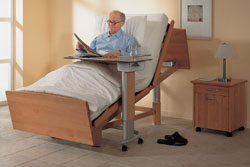 Before purchasing the Turn-Q mattress, a good night’s sleep seemed like a dream to Cindy Collins of Gladstone, Mich. She was up three or four times a night to turn her son Mitch, 18, who has Duchenne MD.
Before purchasing the Turn-Q mattress, a good night’s sleep seemed like a dream to Cindy Collins of Gladstone, Mich. She was up three or four times a night to turn her son Mitch, 18, who has Duchenne MD.
But once insurance approved the purchase of a turning mattress, life changed virtually overnight in the Collins home.
“When he got the mattress, he didn’t wake up at night to be turned or repositioned at all,” Collins said. “It’s been a godsend to us. He sleeps so well, and he’s never had any sores. Not having to reposition Mitch means sleep to me.”
Turning beds provide the ultimate in Space Age technology — the entire bed turns, not just the mattress.
The Freedom Bed from ProBed Medical Technologies is a computer-controlled system that manually or automatically turns the user without caregiver assistance. It ranges between $18,000 and $37,000, depending on selected features.
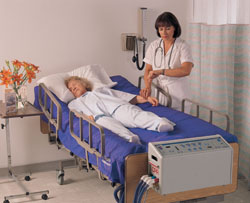 The bed’s motion is timed by computer, and the rate is adjustable to accommodate various sleeping patterns. Caregivers can program the bed for automatic use or adjust any of its operations manually. “Dwell time” in a single position, angle of rotation and turning schedule all can be custom set. Voice-activated systems also are available.
The bed’s motion is timed by computer, and the rate is adjustable to accommodate various sleeping patterns. Caregivers can program the bed for automatic use or adjust any of its operations manually. “Dwell time” in a single position, angle of rotation and turning schedule all can be custom set. Voice-activated systems also are available.
The user determines how long to remain at each of the three dwell positions (horizontal, or up to 30 degrees left or right), with the maximum time in one position being four hours. Here’s an example of a turning schedule:
- Horizontal for 45 minutes
- 30 degrees to the right for 45 minutes
- Horizontal for 45 minutes
- 27 degrees to the left for 60 minutes
- The schedule then automatically repeats.
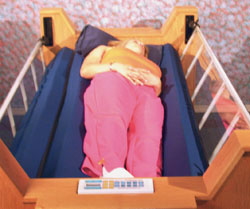 For safety’s sake, the bed’s horizontal surface, which supports the mattress, is hinged into three longitudinal sections. The user is positioned on his or her back in the middle section, and as the bed rotates from a horizontal position to either the right or the left,the user is cradled by the bed’s sections to prevent sliding and friction.
For safety’s sake, the bed’s horizontal surface, which supports the mattress, is hinged into three longitudinal sections. The user is positioned on his or her back in the middle section, and as the bed rotates from a horizontal position to either the right or the left,the user is cradled by the bed’s sections to prevent sliding and friction.
For five years, Wanda Hebert of Concord, N.H., got up every two hours to turn her son, Dan, who has type 2 spinal muscular atrophy. Dan, 24, used a regular hospital bed during that time, and tried a variety of sleep aids, but nothing helped.
After Dan tested a Freedom Bed prototype, the family immediately knew this was the bed.
“We had tried air mattresses before, but they didn’t help,” Wanda Hebert explained. “Once we found this bed, the insurance made us try everything under the sun all over again before it would agree to pay for the Freedom Bed.”
Hebert said lack of sleep was the norm until Dan started using the Freedom Bed.
“The first night, it was a drastic change because he slept the whole night,” she said. “Because of the bed, he got to go to college and be on his own. He had a caregiver help him get to bed but didn’t need to have a caregiver during the night.”
Funding a Good Night's Sleep
To get coverage for a sleep aid by Medicare, Medicaid or private medical insurance, you must provide documentation of medical necessity and be prepared to appeal rejections of coverage. If at first you don’t succeed, try, try and try again.
MDA clinic staff may be able to help explain to insurance companies the importance of rest in treating neuromuscular diseases and why sleep aids are necessary medical equipment. (Note: Never say the sleep aid also would benefit the caregiver; the product must be needed by the person with the muscle disease.)
Some sleep aids can be rented or borrowed. For example, insurance policies often cover hospital bed rentals (if prescribed by a doctor). Or your local MDA loan closet may have hospital-style beds and other sleep aid products, including air mattresses and alternating pressure mattresses, to loan out.
AT funding resources
If you need funding assistance for sleep aids, start by contacting your state’s federally funded Assistive Technology Act pro-gram. These programs, which operate in all states, work to improve access to assistive technology products and services.
State AT programs are expert at putting people in touch with AT resources and providing information about funding sources. They also offer loan and equipment exchange programs.
In addition, the federal/state Alternative Financing Program (AFP) grants low-interest loans to people with disabilities, their families or advocates, in order to purchase assistive technology, including items like turning mattresses.
AFPs operate in 33 states and U.S. territories, with varied guidelines. The loans typically offer low interest rates, loan guarantees, extended repayment periods, support services to keep payments current, and the opportunity to build credit or improve a low credit rating. People who don’t qualify for traditional bank loans may find AFPs more receptive to their applications. They make allowances for poor credit, especially if it’s related to a person’s disability.
Your local independent living center also may have information about AT funding sources in your area. And, if you’re working, check with your state Department of Vocational Rehabilitation to determine whether sleep aids qualify for coverage under assistive technology.
Funding resources
Independent Living Research Utilization Directory of Centers
(713) 520-0232
National Council on Independent Living
(202) 207-0334
Alternative Financing Technical Assistance Project
(703) 524-6686
State Departments of Vocational Rehabilitation
Or check your telephone directory under “State Listing."
Professional organizations
Caregiver Action Network
(800) 896-3650
National Sleep Foundation
(202) 347-3471
Sleep Education.com
(Supported by the American Academy of Sleep Medicine)
Manufacturers
ProCare Medical
Volker Nursing Bed
(800) 321-4240
Invacare
(800) 333-6900
James Consolidated
Volkner Turning System
(800) 884-3317
Mobility Transfer Systems
Transfer Handles
(888) 854-4687
ProBed Medical Technologies
(800) 816-8243
ROHO Group
Mattress overlays
(800) 851-3449
SleepSafe Beds
(866) 852-2337
Supracor
Stimulite Mattress Overlay
(800) 787-7226
Tempur-Pedic
Beds and mattress overlays
(888) 811-5053
Transfer Master Beds
(Adjustable/Hi-Low Beds)
(877) 445-6233
MDA Resource Center: We’re Here For You
Our trained specialists are here to provide one-on-one support for every part of your journey. Send a message below or call us at 1-833-ASK-MDA1 (1-833-275-6321). If you live outside the U.S., we may be able to connect you to muscular dystrophy groups in your area, but MDA programs are only available in the U.S.
Request Information